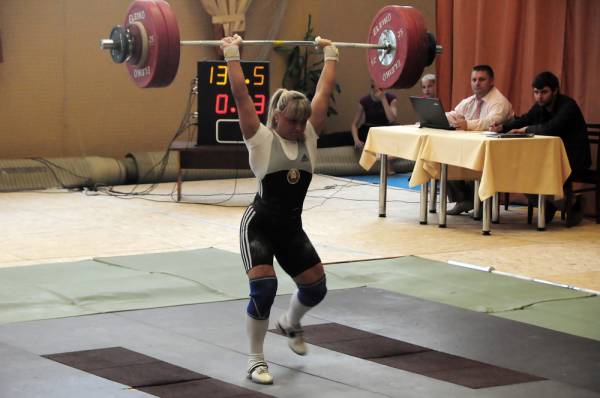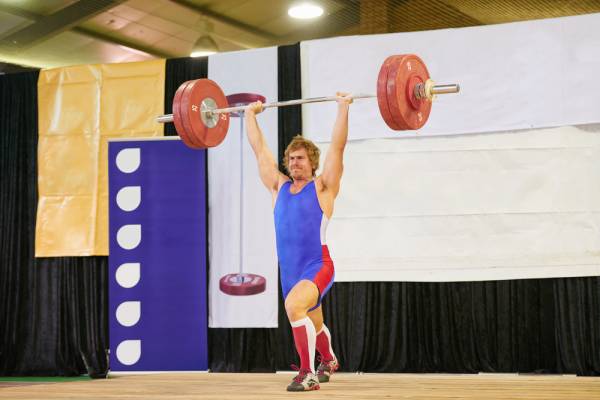As everyone familiar with the Olympic lifts knows, the clean and jerk is a two-part lift. Once the clean is finished, you then have the second lift to deal with – the jerk. Since you have only a short amount of time after the clean to get ready for the jerk, what happens during this brief time is of utmost importance.
Making a quick transition from the clean to the jerk is crucial to completing a successful lift.
When you have arisen from the bottom of your squat or split to a point where your legs are fully extended, it will be time to get ready for the jerk. But a successful jerk cannot be contemplated until a few items have been taken care of.
Foot Position
The best position for receiving the bar in the clean is generally going to be a considerably wider stance than the best position for driving the jerk. This means your feet have to be moved. This is done as soon as you recover from the clean. This does not usually cause much difficulty.
Bar Position
The second item is the positioning of the bar itself. This should be across your deltoids, just above the clavicles. The rules allow you to attempt to jerk from anywhere above the level of your nipples, but it will be difficult to hold a barbell on the chest in any position much lower than the clavicles.
“Many jerks are lost because the lifter does not take the right steps after the clean and before the jerk. “
So aim to get that bar high during the clean. If the bar has been caught low, it is against the rules to move it to a higher position. However, if the bar is too high and is choking you or causing some sort of pain, it is allowable to move the bar down your chest.
Hand Position
The grip itself is not usually a problem. You will use the hook grip in the clean, but not the jerk. Your hook is usually released when the bar turns over in the clean so this will not have to be adjusted in most cases.

The width and intensity of the grip are different matters, though. Two things can happen here:
- You often have only a tenuous grip on the bar with your hands right after the recovery from the clean – so you will want a more secure contact with your fingers.
- The best grip for pulling is not necessarily the best one for getting the bar overhead – so you will want to reposition your hands along the bar.
If you pull with a narrower grip, you may want to move your grip outward some. This is common with less flexible lifters who cannot get the bar back over their heads far enough to stay balanced over their mid-foot.
How these hand repositionings are accomplished is important. They have to be done using as little energy as possible. You can reposition the hands in one of two ways:
- The first way involves driving out of your clean fast enough so the bar leaves your shoulders. In the instant the bar is airborne, you can reposition your hands and grip.
- The second way occurs only after the recovery has ended. In that case, you must perform a slight dip and then drive the bar off your chest and reposition your hands while the bar is in mid-air.
This second approach is okay as long as it does not look like you are making a jerk attempt. Fortunately, most referees can tell the difference between the two. But this second method is less desirable since it takes up more energy than the first. That said, both are better than trying to reposition the hands without driving the bar off of the body. Attempting to do this will often result in losing your grip on the bar and having to drop it.
Note: Some lifters end up having only their fingertips in contact with the bar at the completion of the recovery. Going even further, I once saw a lifter whose hands came completely off the bar at the bottom of the clean, yet he was still able to rise with the bar in position by holding his arms up at about 45 degrees to the floor during the recovery. Most lifters would lose the bar in those circumstances, but this lifter was able to recover, toss the bar up several inches where he grabbed it and, most miraculously, go on to make a successful jerk.
Elbow Position
In addition to all this hand positioning, you may like to reposition your elbows. During the clean, your elbows must be turned completely so they end up in a high position. This does two things:
- It ensures a secure racking of the bar on your chest.
- It ensures that your elbows or upper arms do not come into contact with the knees or thighs. That will be red-lighted.
However, not all lifters can start their jerks with their elbows high. Some like to lower them as they feel they will get a head start on their drive to completion. They may also feel too cramped with high elbows. Either way, this will necessitate a repositioning of the elbows.

Mental Position
Once all the bar and body parts are in position, it is time to get ready to jerk. Psychological pressures will play a big part in determining the success of that jerk. You not only just climbed out of a heavy and taxing clean, but now you have to throw that maximum weight overhead. In that moment between the two lifts, the bar is weighing down on you, telling you that it is very heavy.
Nonetheless, you must gather your resources and start the dip. You cannot have any negative thoughts in your mind. You can only think about driving the weight overhead and jumping underneath to catch it. Courage and commitment are the watchwords here.
“Since you have only a short amount of time after the clean to get ready for the jerk, what happens during this brief time is of utmost importance.”
There is no room for hesitation. The longer you wait, the lower your chances of success will be. That bar is heavy and that will work on your mind, so hop to it. You must commit yourself to the task. Not to mention, you cannot change your mind and start over. That would be a second jerk and will get you red lights.
Training Considerations
The things that must be considered after the clean and before the jerk are:
- Foot position
- Bar position
- Grip width
- Degree of grip
- Elbow position
- Mental engagement
Many jerks are lost because the lifter does not take the right steps after the clean and before the jerk. How much time elapses between the two is of vital importance in the success of the lift. You must consider this phase of the lift as one more aspect of your technique that must be mastered.
Check out these related articles:
- Would You Be Better Off Power Jerking?
- A Jerk Is a Jerk (and a Press Is a Press)
- A Step-By-Step Guide to the Perfect Jerk
- What’s New On Pulse Beat Fit Today
Photos courtesy of Shutterstock.






